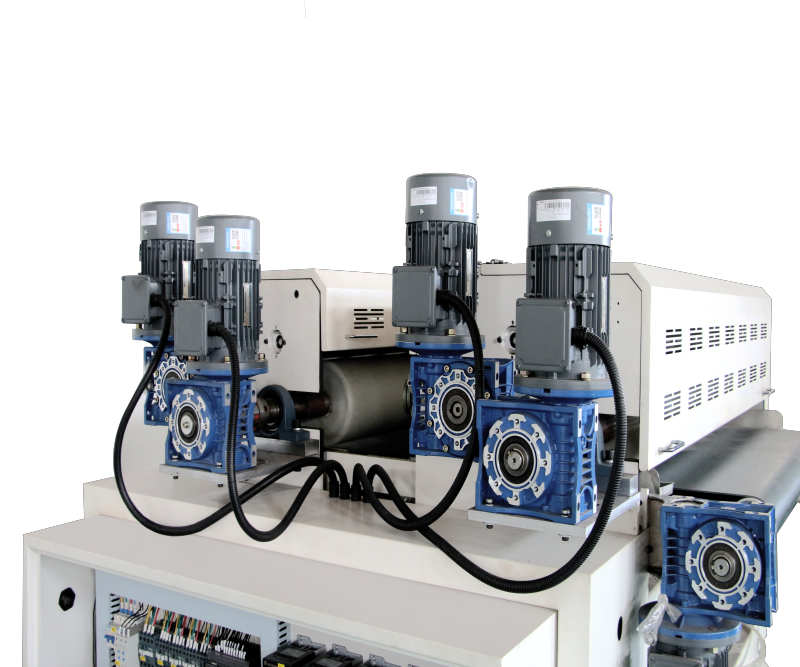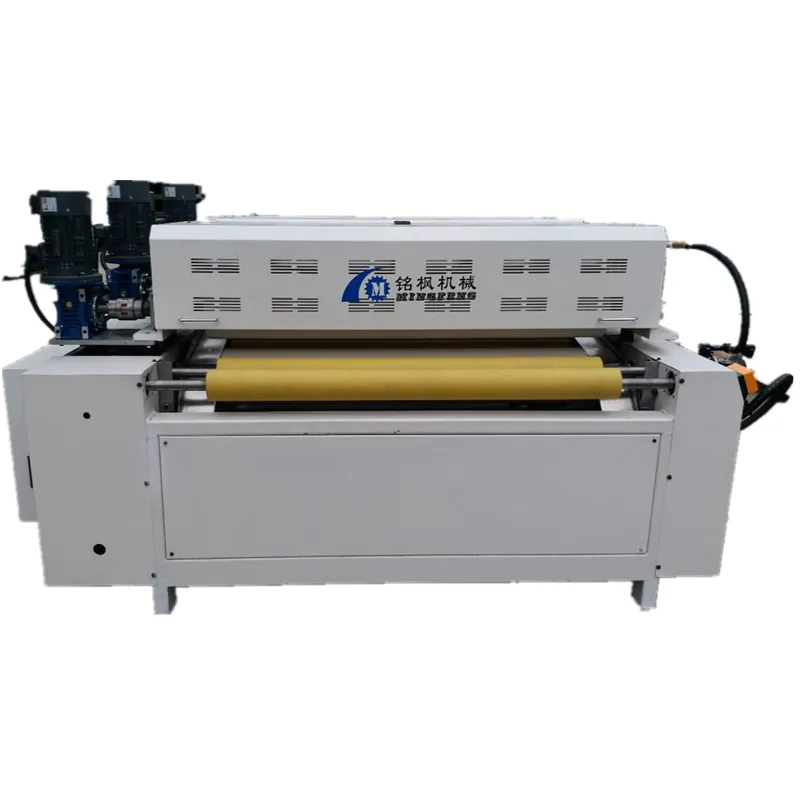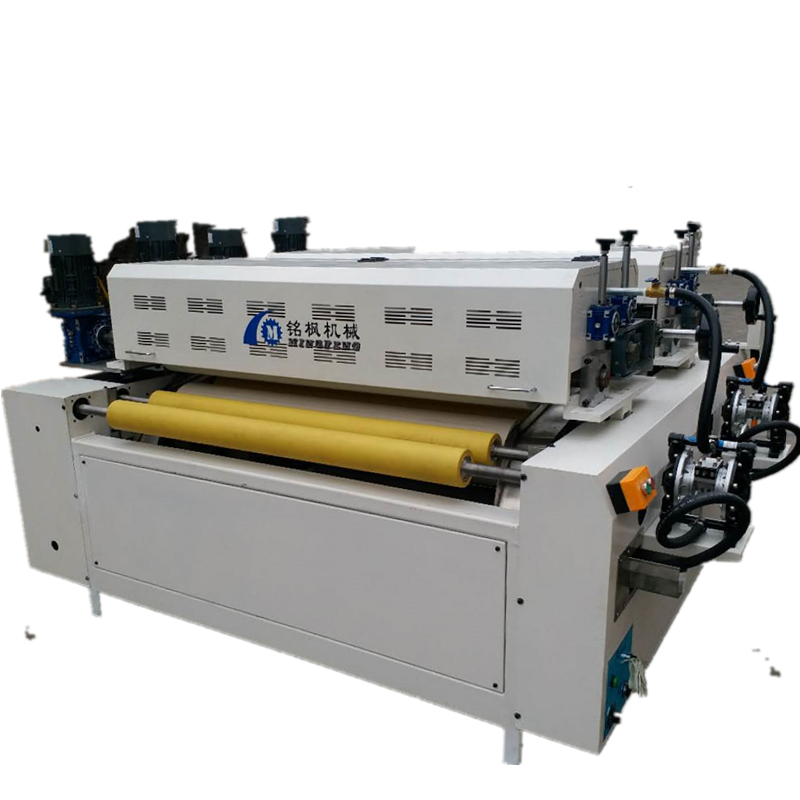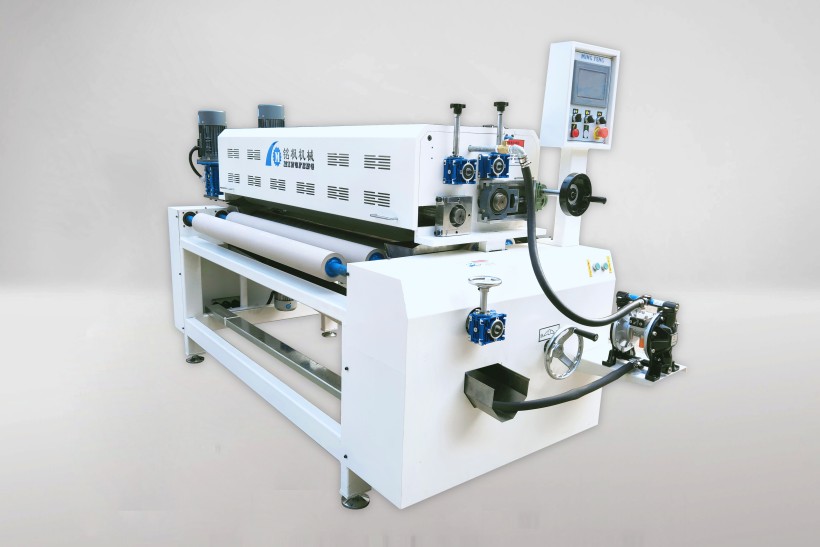In wood product surface treatment processes, selecting the appropriate coating equipment is a crucial factor affecting product appearance quality, durability, and production efficiency. With the widespread application of ultraviolet (UV) curing technology, UV roller coating machines have gradually become common automated equipment in furniture manufacturing, flooring coating, and wooden door processing.
However, many companies have questions during application: Is a UV roller coating machine suitable for solid wood board surfaces? Solid wood boards differ significantly from ordinary boards (such as MDF, melamine board, and PVC board) in structure, adhesion, and surface smoothness. Can a UV roller coating machine meet the special requirements of solid wood surfaces?
This article will systematically analyze this issue from the aspects of coating principles, material characteristics, coating adhesion, curing reaction, and process matching.

What is a UV roller coating machine?
A UV roller coating machine is an automated coating device that uses ultraviolet curing technology. It uses a precision roller system to evenly coat the substrate surface with UV coating, followed by UV irradiation, causing the coating molecules to cross-link and cure in a very short time, forming a high-hardness, high-gloss coating.
The main workflow is as follows:
• Feeding system: Transports the UV coating to the roller surface;
• Metering and coating rollers: Control the coating thickness to ensure uniform coating;
• Conveying system: The solid wood board smoothly passes through the roller area;
• UV curing system: UV irradiation instantly cures the coating;
• Cooling and collecting system: Prevents overheating and maintains the stability of the board shape.
This method has advantages such as high speed, short curing time, high coating smoothness, and high production efficiency.

How do the characteristics of solid wood boards affect the coating process?
To determine whether a UV roller coating machine is suitable for solid wood boards, it is necessary to understand the physical and chemical properties of the solid wood material itself.
1. Natural and irregular texture
The surface of solid wood boards has natural wood grain, pores, knots, and other structures. These characteristics result in uneven surface roughness and differences in the ability to absorb coatings.
2. Significant Moisture Content Variation
Solid wood boards are extremely sensitive to environmental humidity. Changes in moisture content can cause warping or cracking, thus affecting the adhesion of the UV coating.
3. Inconsistent Surface Hardness
Different wood species (such as oak, beech, maple, cherry, etc.) have significant differences in hardness, affecting the penetration and leveling properties of the coating.
4. Presence of Oils or Tannins
Some woods contain natural oils, which can affect the bonding strength between the UV coating and the wood fibers.
Therefore, solid wood boards do not have a completely flat and dense surface like engineered wood boards, which poses a challenge to the application of UV roller coating machines.

Can UV roller coating machines be used directly on solid wood board surfaces?
Strictly speaking, UV roller coating machines can be used on solid wood boards, but certain conditions must be met and the process adjusted.
This is because UV roller coating machines are designed for high-precision coating on flat, smooth substrates, while solid wood board surfaces often have undulations and differences in adhesion. If applied directly to the machine, the following problems are likely to occur:
• Uneven coating thickness;
• Insufficient coating in wood grain recesses;
• Surface bubbles, pinholes, and shrinkage cavities;
• Incomplete curing or insufficient adhesion.
Therefore, when using a UV roller coating machine on solid wood boards, it is essential to optimize the effect through pretreatment, primer sealing, and adjustments to viscosity and pressure.
What pretreatment is required for using a UV roller coating machine on solid wood boards?
Pretreatment is crucial for making solid wood boards suitable for UV roller coating machines.
1. Sanding and Smoothing
Use a belt sander to finely sand the surface of the solid wood board (grit 240-320 recommended) to reduce wood grain undulations and improve smoothness.
2. Sealer Treatment
Before applying UV coating, a layer of sealer should be sprayed or roller-coated to reduce wood absorption and prevent internal moisture evaporation.
3. Dust and Oil Removal
Wood dust, grease, or impurities can all affect coating adhesion.
4. Use electrostatic dust removal equipment to ensure surface cleanliness
The moisture content of solid wood should be controlled between 8% and 12%. Too high or too low a moisture content will lead to coating deformation or poor adhesion.
After the above treatment, the solid wood board surface will be ready for stable coating by a UV roller coating machine.
Are different types of solid wood suitable for UV roller coating machines?
Not all solid woods will achieve ideal results. Based on the characteristics of the wood species, they can be roughly divided into the following categories:
Wood Species | Surface Characteristics | Compatibility | Notes |
| Maple, Beech, Birch | Fine surface, small pores | ★★★★★ | Best suited for UV roller coating |
| Oak, Teak | Larger pores, high oil content | ★★★☆☆ | Requires a sealing primer before application |
| Cherry, Walnut | Distinct texture | ★★★★☆ | Can be applied, but requires multiple coats |
| Pine, Fir | High resin content, soft texture | ★★☆☆☆ | Easy to penetrate, weak coating adhesion |
Therefore, UV roller coating machines are more suitable for hard, fine-grained, and smooth solid wood boards.
For oily or highly porous woods, it is necessary to strengthen the undercoating and sanding steps.
How to control process parameters when using a UV roller coating machine on solid wood boards?
To obtain the ideal coating effect, it is essential to precisely control various process parameters. These mainly include:
1. Roller gap and pressure
Adjust the roller pressure to ensure the coating evenly covers the wood grain recesses. The pressure is usually between 0.3 and 0.6 MPa.
2. Coating Viscosity
Too high a viscosity can cause buildup, while too low a viscosity can lead to sagging. A viscosity of 25–35 seconds (Ford Cup 4) is recommended.
3. Roller Coating Speed
Generally controlled at 8–20 m/min, adjusted appropriately based on the flatness of the board surface.
4. UV Lamp Power and Curing Time
The UV lamp power should be controlled at 80–120 W/cm. The curing speed is directly proportional to the coating thickness.
5. Ambient Temperature and Humidity
The recommended ambient temperature is 22–28℃, and the humidity is 45–60% to ensure coating fluidity and adhesion.

What are the advantages of using a UV roller coating machine on solid wood boards?
With proper process adjustments, UV roller coating machines can exhibit significant advantages on solid wood boards:
1. Smooth and Glossy Coating
The surface after UV curing is high-gloss, wear-resistant, and scratch-resistant, greatly enhancing the visual appeal of solid wood.
2. Superior Environmental Performance
UV coatings are solvent-free systems, containing almost no VOCs, meeting environmental standards.
3. High Production Efficiency
Curing time is only a few seconds, enabling continuous production and suitable for mid-to-high-end furniture and flooring manufacturing.
4. Stable Coating Performance
The coating film is dense, resistant to yellowing and chemicals, extending the lifespan of solid wood products.
What are the limitations of UV roller coating machines in solid wood applications?
While offering significant advantages, certain limitations exist:
1. High Requirements for Surface Smoothness: Uneven coating is difficult to completely avoid if the solid wood board is uneven.
2. Complex Process: Solid wood requires multiple processes such as sealing, sanding, primer, and topcoat to achieve optimal results.
3. High Equipment Investment: UV roller coating machines and their associated UV curing systems are expensive, making them suitable for mass production.
4. Strict Maintenance Requirements: Lamp tubes, rollers, and filtration systems require regular maintenance; otherwise, coating quality will be affected.
How to Determine if the UV roller coating machine's coating effect is satisfactory?
The main criteria for judging coating quality include the following:
• Smooth and glossy appearance: No pinholes, shrinkage cavities, or runs;
• Strong adhesion: No peeling after cross-cut adhesion or scratch test;
• Moderate hardness: Pencil hardness ≥ H;
• Good abrasion resistance: No significant damage after abrasion test;
• Complete curing: Dry to the touch, no stickiness.
If defects occur, check the following aspects one by one: temperature, coating viscosity, UV lamp power, and substrate moisture content.
Does XMF Machinery only serve large factories?
No, XMF Machinery serves both small businesses and large-scale factories. Whether you are purchasing a single machine or an entire production line, our company offers flexible sales and supply options. Small buyers benefit from low prices, factory discounts, and promotions, while larger factories can purchase wholesale and receive customized quotes.
Our brand is recognized for high-quality equipment and professional service, making it easy for any buyer to purchase coating machines directly from a manufacturer.
